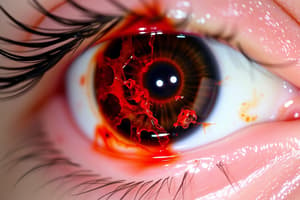Podcast
Questions and Answers
What is the most common form of jerk nystagmus?
What is the most common form of jerk nystagmus?
- Vestibular nystagmus
- Pendular nystagmus
- Gaze-evoked nystagmus (correct)
- Downbeat nystagmus
Which type of nystagmus is associated with lesions near the craniocervical junction?
Which type of nystagmus is associated with lesions near the craniocervical junction?
- Vestibular nystagmus
- Pendular nystagmus
- Downbeat nystagmus (correct)
- Gaze-evoked nystagmus
What can provoke peripheral vestibular nystagmus?
What can provoke peripheral vestibular nystagmus?
- Anticonvulsant intoxication
- Sudden shifts in head position (correct)
- Alcoholism
- Lithium medication
What is a common etiology for pendular nystagmus?
What is a common etiology for pendular nystagmus?
What is the treatment for macular edema?
What is the treatment for macular edema?
What may require urgent referral to an ophthalmologist for hypercoagulable workup?
What may require urgent referral to an ophthalmologist for hypercoagulable workup?
What is amaurosis fugax?
What is amaurosis fugax?
What may worsen glaucoma?
What may worsen glaucoma?
What is the leading cause of blindness?
What is the leading cause of blindness?
What is amblyopia characterized by?
What is amblyopia characterized by?
What is the treatment for neovascularization?
What is the treatment for neovascularization?
What is the aim of strabismus treatment?
What is the aim of strabismus treatment?
What is the characteristic of open-angle glaucoma?
What is the characteristic of open-angle glaucoma?
What does closed-angle glaucoma diagnosis require?
What does closed-angle glaucoma diagnosis require?
What affects 4% of children and is often associated with familial factors?
What affects 4% of children and is often associated with familial factors?
How is glaucoma treated?
How is glaucoma treated?
What is the common cause of optic neuropathies in older adults with sudden loss of half upper or lower field of vision?
What is the common cause of optic neuropathies in older adults with sudden loss of half upper or lower field of vision?
What urgent treatment is required for arteritic anterior ischemic optic neuropathy (AAION) to prevent blindness?
What urgent treatment is required for arteritic anterior ischemic optic neuropathy (AAION) to prevent blindness?
What is a common symptom of toxic optic neuropathy?
What is a common symptom of toxic optic neuropathy?
What is the characteristic feature of Leber's hereditary optic neuropathy?
What is the characteristic feature of Leber's hereditary optic neuropathy?
What is the cause of orbital cellulitis usually associated with?
What is the cause of orbital cellulitis usually associated with?
What is the main symptom of orbital cellulitis?
What is the main symptom of orbital cellulitis?
What is the treatment for orbital cellulitis?
What is the treatment for orbital cellulitis?
What is the cause of preseptal cellulitis, a milder form not involving the globe, more common in pediatric population?
What is the cause of preseptal cellulitis, a milder form not involving the globe, more common in pediatric population?
What is the characteristic feature of posterior ischemic optic neuropathy?
What is the characteristic feature of posterior ischemic optic neuropathy?
What is the cause of optic disc drusen, refractile particles in the optic nerve?
What is the cause of optic disc drusen, refractile particles in the optic nerve?
What is the presentation of papilledema, indicating elevated intracranial pressure?
What is the presentation of papilledema, indicating elevated intracranial pressure?
What are the signs and symptoms of open globe fracture?
What are the signs and symptoms of open globe fracture?
What is the recommended treatment for hyphema?
What is the recommended treatment for hyphema?
What is the characteristic presentation of central retinal artery occlusion?
What is the characteristic presentation of central retinal artery occlusion?
What is the recommended initial approach for central retinal artery occlusion?
What is the recommended initial approach for central retinal artery occlusion?
What is the characteristic appearance of central retinal vein occlusion?
What is the characteristic appearance of central retinal vein occlusion?
What are the risk factors for central retinal vein occlusion?
What are the risk factors for central retinal vein occlusion?
What is the recommended treatment for central retinal vein occlusion?
What is the recommended treatment for central retinal vein occlusion?
What is the immediate management for microhyphema suggestive of fulminant ocular infection?
What is the immediate management for microhyphema suggestive of fulminant ocular infection?
What is the initial treatment for blunt or penetrating trauma resulting in open globe fracture?
What is the initial treatment for blunt or penetrating trauma resulting in open globe fracture?
What is the effect of hyphema on vision if left untreated?
What is the effect of hyphema on vision if left untreated?
What is the consequence of increasing intraocular pressure in the context of ocular trauma?
What is the consequence of increasing intraocular pressure in the context of ocular trauma?
What is the recommended approach for immediate management of central retinal artery occlusion?
What is the recommended approach for immediate management of central retinal artery occlusion?
What is the characteristic feature of atrophic (dry) macular degeneration?
What is the characteristic feature of atrophic (dry) macular degeneration?
What is the key symptom of diabetic retinopathy?
What is the key symptom of diabetic retinopathy?
What is the primary treatment for hypertensive retinopathy?
What is the primary treatment for hypertensive retinopathy?
What is the prognosis for retinal detachment if promptly treated?
What is the prognosis for retinal detachment if promptly treated?
What is the earliest stage of retinal involvement in diabetic retinopathy?
What is the earliest stage of retinal involvement in diabetic retinopathy?
What is the characteristic sign of hypertensive retinopathy?
What is the characteristic sign of hypertensive retinopathy?
What is the key factor in preventing diabetic retinopathy?
What is the key factor in preventing diabetic retinopathy?
What is the characteristic feature of wet macular degeneration?
What is the characteristic feature of wet macular degeneration?
What is the primary diagnostic method for diagnosing wet macular degeneration?
What is the primary diagnostic method for diagnosing wet macular degeneration?
What is the characteristic presentation of retinal detachment?
What is the characteristic presentation of retinal detachment?
What is the primary treatment for atrophic (dry) macular degeneration?
What is the primary treatment for atrophic (dry) macular degeneration?
What is the key factor in the improved outcomes of wet macular degeneration?
What is the key factor in the improved outcomes of wet macular degeneration?
Flashcards are hidden until you start studying
Study Notes
Ocular Trauma and Emergency Eye Conditions
- Blunt or penetrating trauma can cause open globe fracture
- Signs and symptoms include corneal or scleral laceration, peaked pupil, and decreased visual acuity
- Immediate ophthalmology consult is necessary with avoidance of increasing intraocular pressure
- Treatment includes no eye manipulation, eye shield placement, and IV antiemetic therapy
- Hyphema, blood in the anterior chamber, can result in permanent vision loss
- Treatment for hyphema involves head of bed elevation and correction of coagulopathy if present
- Microhyphema, suggestive of fulminant ocular infection, requires immediate ophthalmologist attention
- Central retinal artery occlusion presents as painless monocular vision loss and requires emergent referral to ophthalmology
- Treatment may involve tPA or ocular massage, with checks for ESR, CRP, and hypercoagulable workup
- Central retinal vein occlusion is characterized by painless monocular vision loss with "blood & thunder" appearance
- VEGF inhibitors are used in the treatment of central retinal vein occlusion
- Risk factors include diabetes, hypertension, cardiovascular disease, and smoking
Common Retinal Disorders and Their Treatment
- Wet macular degeneration is characterized by breakdown of cells in the macula, most commonly occurring in individuals over 50 and associated with smoking.
- Diagnosing wet macular degeneration involves fundoscopic exam, fluorescein angiography, and Amsler grid test, with early use of VEGF-inhibitors showing improved outcomes.
- Atrophic (dry) macular degeneration is characterized by extracellular debris deposits around the macula, resulting in gradual progressive bilateral vision loss.
- Treatment for atrophic macular degeneration includes intraocular injection of VEGF antagonists and lifestyle changes, such as stopping smoking and adopting a Mediterranean diet.
- Retinal detachment can lead to sudden visual field loss and is related to retinal tear, often preceded by floaters or shadow-like disturbances.
- Prognosis for retinal detachment is good if promptly treated, with 80% recovery rate without recurrence, but detachment of the contralateral eye occurs in 25% of cases.
- Hypertensive retinopathy can be classified as mild, moderate, or severe based on fundoscopic exam and may present with various signs and symptoms such as AV nicking, retinal hemorrhages, and optic disc edema.
- Treatment for hypertensive retinopathy involves better management of hypertension and emergent management of pressure if papilledema is present.
- Diabetic retinopathy, a leading cause of blindness in the US, can be nonproliferative or proliferative, with symptoms including spots floating in vision, blurred vision, and dark streaks.
- Nonproliferative diabetic retinopathy is the earliest stage of retinal involvement, while proliferative diabetic retinopathy is the most severe type, characterized by abnormal blood vessels growing in the retina.
- Treatment for diabetic retinopathy involves prevention through good glycemic, BP, and lipid control, and may include VEGF inhibitors, laser, or surgical vitrectomy.
- Diabetic retinopathy is characterized by microaneurysms, cotton wool spots, and exudates on exam, with prevention being key through good glycemic, BP, and lipid control.
Studying That Suits You
Use AI to generate personalized quizzes and flashcards to suit your learning preferences.




